Do You Have a Swarm?
Over the last few weeks we have been inundated with emails about 'swarms' a lot of these turn out to be Bumble Bees, below is a step-by-step guide to identifying who's who.









Over the last few weeks we have been inundated with emails about 'swarms' a lot of these turn out to be Bumble Bees, below is a step-by-step guide to identifying who's who.
 Bumblebees
BumblebeesCommon Carder Bee - Bombus pascuorum - 1.3cm
Red-tailed Bumblebee - Bombus lapidarius - 2.3cm
White-tailed Bumblebee - Bombus lucorum - 2.2cm (Pictured)
Early bumblebee - Bombus pratorum - 1.6 - 1.8 cm
Small garden bumblebee - Bombus hortorum - 2.0 - 2.4 cm
Tree bumblebee - Bombus hypnorum - 1.0 - 1.6 cm
The queen emerges from hibernation in spring and starts the colony by laying a few eggs that hatch as workers, these workers tend the young and nest. Males emerge later and mate with new females who are prospective queens. With Bumble Bees both the males and old queen die in the autumn, the new queens hibernate over Winter.
Bumble Bees like to nest in Bird Boxes, Electricity meter boxes, under Decking, under the eves of your house, to name a few locations. Allthough they can sting, they rarely do, normal only stinging when they are protecting the nest or have been trapped in something (like your washing!).
Beekeepers will not collect/remove Bumblebees.
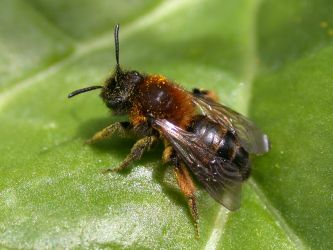 Solitary bees - Andrena fulva
Solitary bees - Andrena fulvaLeaf-cutter Bee - Megachile centuncularis - 1.3cm
Red Mason Bee - Osmia rufa - 0.6-1.1cm
Tawny Mining Bee - Andrena fulva - 1.8cm
Ivy bee - Colletes hederae - 1.0 - 1.3cm
There are a lot of species of solitary bee in Britain around 200. They get there name because, unlike honeybees and bumblebees, they do not live in colonies. The Solitary bee looks similar to honeybees in appearance, but they lack pollen baskets on their hind tibiae. They make nests in the ground, usually in sandy soil and along paths. All solitary bees are excellent pollinators and should be encouraged into your garden.
Beekeepers will not collect/remove Solitary bees.
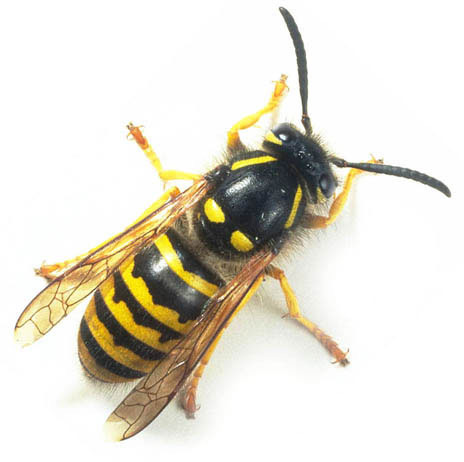 Wasps
Wasps Wasp - Vespula vulgaris
Wasps live in colonies. The make-up of these colonies is similar to that of honeybees, with a dominant reproductive queen, reproductive males (drones) and non-reproductive worker females. The workers spend much of their time foraging, and wasps are important predators of insect pests such as caterpillars and other small soft-bodied insects. In autumn, when the queen stops producing eggs, the workers no longer have their food, forcing them to search for replacement sources of sugar. Normally, this would be found on rotting fruit, but the abundance of sweet human foods such as jam encourages them to invite themselves to our tables. This explains why wasps are generally only a nuisance in the autumn.
Beekeepers will not collect/remove Wasps.
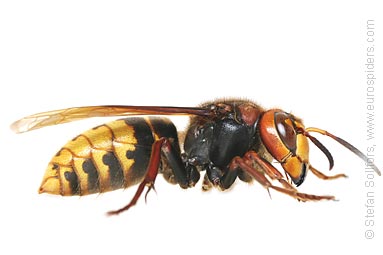 Hornets
Hornets Hornet - Vespa crabro - 2-3.5cm in length
A very large relative of the Common Wasp, the Hornet lives mostly in woodland and parkland where it builds a large, paper nest in a hollow tree, old building or even roof spaces. The queens emerge from hibernation in spring and start to build the nest by chewing up wood. Inside the nest, sterile workers hatch and take over looking after the new young produced by the queen. At the end of summer, reproductive males and queens develop and leave the nest to mate. The males and previous queen die, and the new females hibernate, ready to emerge next spring and start the cycle again.
Beekeepers will not collect/remove Hornets.
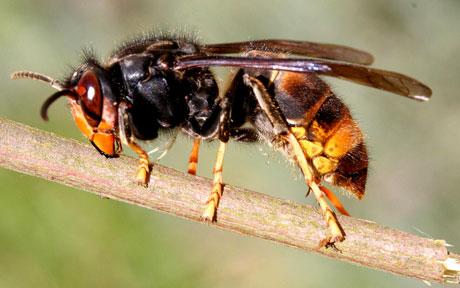 Asian hornet - Vespa velutina
Asian hornet - Vespa velutinaAsian hornet - Vespa velutina - 5cm in length
An invasive non-native hornet originally from Asia. Suspected records should be reported immediately. A highly aggressive
predator of native insects, posing a significant threat to honey bees and other pollinators. Accidentally introduced
to France in 2004 and spreading rapidly. Not yet present in the UK but likely to arrive soon.
If you find a Hornet nest do not disturb it.
Identifying marks:-
Entirely dark brown or black velvety body, bordered with a fine yellow band.
Only one band on the abdomen: 4th abdominal segment almost entirely yellow/orange.
Legs brown with yellow ends.
Head black with an orange-yellow face.
Beekeepers will not collect/remove Asian Hornet. But report them Here
If your insects do not look like this, go to step 3

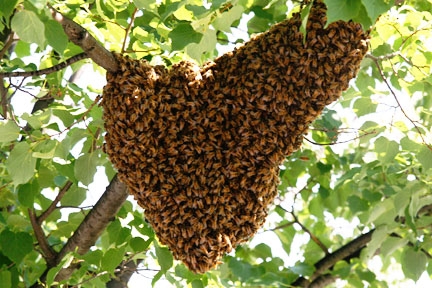 Honeybees - Apis mellifera
Honeybees - Apis melliferaHoneybees are small about 12-18mm in length, and vary in colour from a golden brown to nearly black. Honeybees live in large colonies numbering between 10,000 to 100,000. To the left is a picture of a swarm hanging from a tree.
Beekeepers will collect/remove Honey Bees.
What should you do next? Click on the 'My local' page or click here to find your local Beekeeping Club, contact them and they will be able to help.